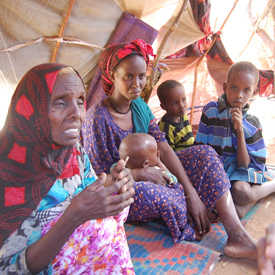Somalis flee famine as drought grips east Africa
The mass exodus of starving Somali refugees is becoming an unbearable crisis as aid agencies launch an emergency appeal to help millions facing the worst east African drought in decades.

An influx of Somali refugees into neighbouring Kenya and Ethiopia continues unabated as hundreds of thousands desperately seek food and water amid a critical drought.
Seasons of poor rain have seen crops fail and animals perish while local food prices soar.
In the worst-hit areas, 60 per cent of livestock has already died, and the remainder is either sick or dangerously underweight.
Where food is available, prices are often too expensive for those with nothing viable to sell.
On Tuesday, Oxfam launched its largest ever Africa appeal of £50m in response to the food crisis, which is affecting more than 12 million people across the Horn of Africa.
Save the Children launched a £40m appeal to help people in Somalia and Kenya who are at risk of starvation, and the British Red Cross is also calling for funds.
‘Tragedy of unimaginable proportions’
Somalia, Djibouti, Ethiopia, Kenya and Uganda are among countries in a vast African region being affected by severe drought.
The UN has warned that the situation is deteriorating to the point of famine in some areas, with hundreds of thousands facing starvation in the next three months – the year’s driest period.
In Somalia, continuing violence in southern and central parts of the country, compounded by drought, has seen 135,000 people flee so far this year.
In June alone, 54,000 people fled across the borders into Kenya and Ethiopia – three times the number of people who fled in May.
The UN Refugee Agency warned on Tuesday that more than 50 per cent of Somali children arriving in Ethiopia are seriously malnourished.
As families walk for days and sometimes weeks to reach refuge at camps in Somalia’s neighbouring countries, vulnerable children are often too weak to survive the journey.
In pictures: Dadaab refugee emergency
While those reaching refugee camps are given food and medical care, the UN said on Tuesday that reaching people inside Somalia was often impossible.
“Knowing that children are dying along their journey to safety breaks our hearts,” Antonio Guterres, UN High Commissioner for Refugees, said on Tuesday.
“This is turning one of the world’s worst humanitarian crises into a human tragedy of unimaginable proportions.”
Refugee influx
In Kenya’s Dadaab refugee complex, people are arriving at a rate of 1,400 a day.
Dadaab – made up of three sprawling encampments – is the world’s largest refugee camp and homes 382,000 people in a complex originally built for 90,000.
By the end of 2011 it is estimated that 450,000 people will live at the camp.
The UN has declared a state of emergency at Dadaab as, at four times above capacity, aid workers are struggling to deal with the influx of people.
Many of the refugees have walked for over a month to reach the encampment and arrive exhausted, malnourished and without possessions.
Once at the camp, refugees have to tackle a chaotic system in order to register and receive food, water and essential supplies such as blankets and cooking utensils.
Some have to wait days, or even weeks, as the backlog of new arrivals grows while makeshift shelters spring up outside Dadaab, made from twigs, string and torn cloth.
The UN Refugee Agency has called on governments and individual donors to urgently support aid agencies and help those in need.
